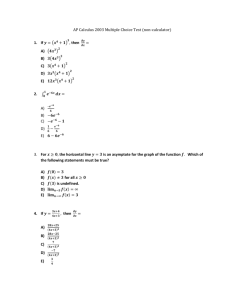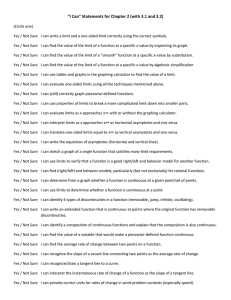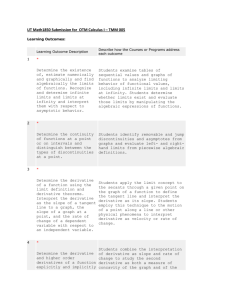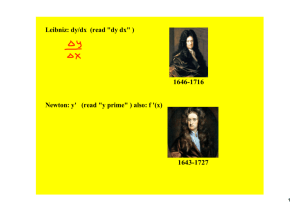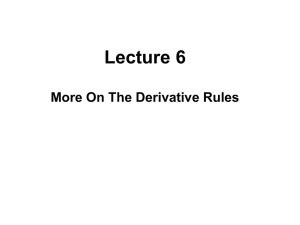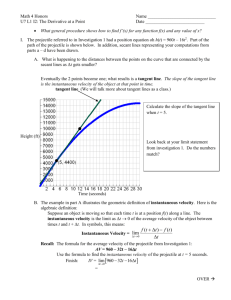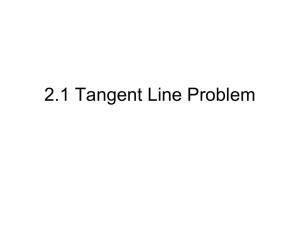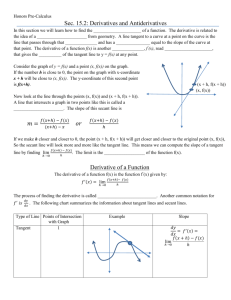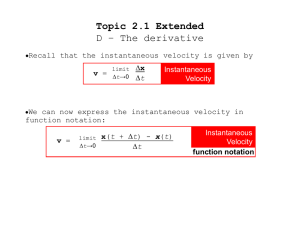M 112 Short Course in Calculus
advertisement
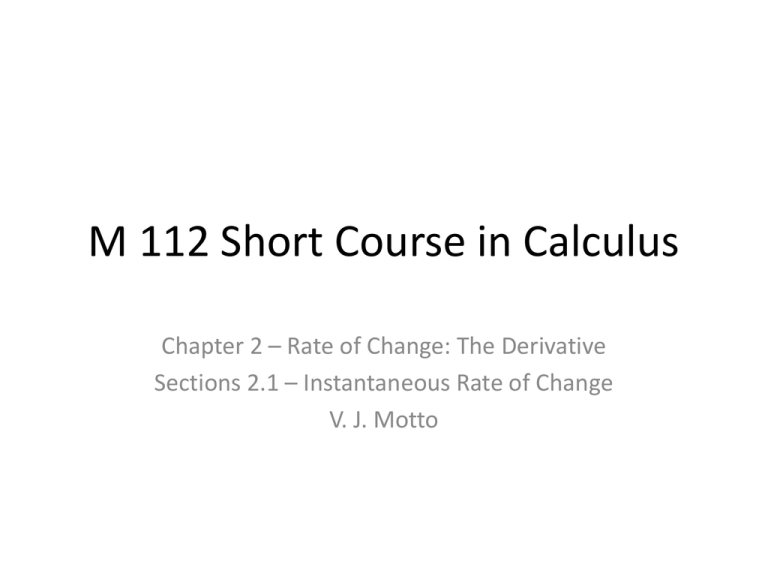
M 112 Short Course in Calculus Chapter 2 – Rate of Change: The Derivative Sections 2.1 – Instantaneous Rate of Change V. J. Motto Instantaneous Rate of Change 4/8/2015 2 So we have the function; s(t) = -16t2 + 100 t + 6 4/8/2015 3 Let’s look over smaller and smaller intervals in the neighborhood of t = 1 Figure 2.1: Average velocities over intervals on either side of t = 1 showing successively smaller intervals 4/8/2015 4 Some basic definitions 4/8/2015 5 Example 1 (page 89) The quantity (in mg) of a drug in the blood at time t (in minutes) is given by Q = 25(0.8)t. Estimate the rate of change of the quantity at t = 3 and interpret your answer. What kind of function is this? What is the domain and range? 4/8/2015 6 Solution We estimate the rate of change at t = 3 by computing the average rate of change over intervals near t = 3. We can make our estimate as accurate as we like by choosing our intervals small enough. Let’s look at the average rate of change over the interval 3 ≤ t ≤ 3.01: Average rate of change 4/8/2015 Q Q(3.01) Q(3) t 3.01 3.00 7 Solution (continued) Q Q(3.01) Q(3) Average rate of change t 3.01 3.00 3.01 3 25(0.8) 25(0.8) A reasonable estimate 3.01 3.00 for the rate of change 12.7715 12.80 of the quantity at t = 3 3.01 3.00 is −2.85 mg/minute. 2.85 4/8/2015 8 Another Basic definition 4/8/2015 9 Example 2 (page 90) Estimate f′ (2) if f(x) = x3. What does the graph of f look like? What is the domain and range of f? 4/8/2015 10 Solution (continued) Since f′(2) is the derivative, or rate of change, of f(x) = x3 at 2, we look at the average rate of change over intervals near 2. Using the interval 2 ≤ x ≤ 2.001, we see that Average rate of change 4/8/2015 f f (2.001) f (2) x 2.001 2.00 (2.001)3 (2)3 2.001 2.00 8.0120 8 0.001 12.0 11 Visualizing the Derivative of a function Figure 2.2: Visualizing the average rate of change of f between a and b 4/8/2015 Figure 2.3: Visualizing the instantaneous rate of change of f at a 12 4/8/2015 13 Example 3 (page 90) Use a graph of f(x) = x2 to determine whether each of the following quantities is positive, negative, or zero: (a) f′(1) (b) f′(−1) (c) f′(2) (d) f′(0) 4/8/2015 14 Solution What is the domain? What is the range? 4/8/2015 15 Solution (continued) Figure 2.5 shows tangent line segments to the graph of f(x) = x 2 at the points x = 1, x = −1, x = 2, and x = 0. Since the derivative is the slope of the tangent line at the point, we have: (a) f′(1) is positive. (b) f′(−1) is negative. (c) f′(2) is positive (and larger than f′(1)). (d) f′(0) = 0 since the graph has a horizontal tangent at x = 0. 4/8/2015 16 Example 2 (page 92) The graph of a function y = f(x) is shown in Figure 2.7. Indicate whether each of the following quantities is positive or negative, and illustrate your answers graphically. 4/8/2015 17 Solution Since there are no y-values, I can’t find a model for this function. I must work with the graph. (a) Since f ′(1) is the slope of the graph at x = 1, we see in Figure 2.8 that f′(1) is positive. 4/8/2015 18 Solution (continued) (b) The difference quotient is the slope of the secant line between x = 1 and x = 3. We see from Figure 2.9 that this slope is positive. 4/8/2015 19 Solution (continued) (c) Since f(4) is the value of the function at x = 4 and f(2) is the value of the function at x = 2, the expression f(4) − f(2) is the change in the function between x = 2 and x = 4. Since f(4) lies below f(2), this change is negative. See Figure 2.10. 4/8/2015 20 Example 4 (Page 92) The total acreage of farms in the US1 has decreased since 1980. See Table 2.2. a) What was the average rate of change in farm land between 1980 and 2000? b) Estimate f′(1995) and interpret your answer in terms of farm land. 4/8/2015 21 Solution (a) Between 1980 and 2000, 945 1039 2000 1980 94 20 47 Average rate of change million acres per year. Between 1980 and 2000, the amount of farm land was decreasing at an average rate of 4.7 million per year. 4/8/2015 22 Solution (continued) (b) We use the interval from 1995 to 2000 to estimate the instantaneous rate of change at 1995: f '(1995) Rate of Change in 1995 945 963 2000 1995 18 5 3.6 million acres per year. In 1995, the amount of farm land was decreasing at a rate of approximately 3.6 million acres per year. 4/8/2015 23 An Alternative Solution Find a model for this data: 4/8/2015 24 Alternative Solution (continued) So we have the function f(x) = 0.05x2 – 5.83x + 1039.31 Average rate of change is still the slope of the secant! But the can actually find the instantaneous rate of change --- the first derivative by using the function f and our calculator: That is f′(15) = -4.197. 4/8/2015 25 First Derivative Function TI 83/84 1. Math Button 2. Option 8:nDeriv( 3. When you press ENTER the function appears on the HOME Screen. We need to add the parameters. 4. nDeriv( y1, x, 15). The first parameter is found using the VARS button. Find the derivative with respect to the x variable, and the let x = 15. Don’t forget to close the parenthesis. 5. Press the Enter key to calculate 4/8/2015 26 First Derivative Function TI-89 1. 2. 3. 4. 5. 6. From the HOME Screen press F3 to get to the calculus functions Choose option 1 d( differentiate Add the parameters y1(x) by typing all the characters. Then add a comma followed by the variable x, and the close the parenthesis. Add the characters |x=15 When you press ENTER to calculate 4/8/2015 27

